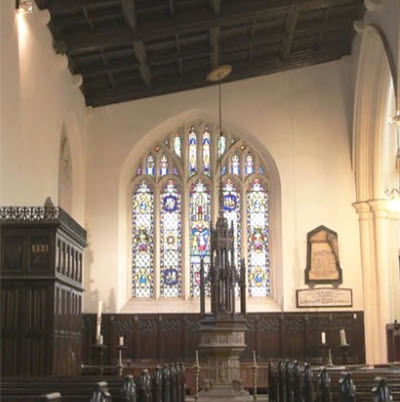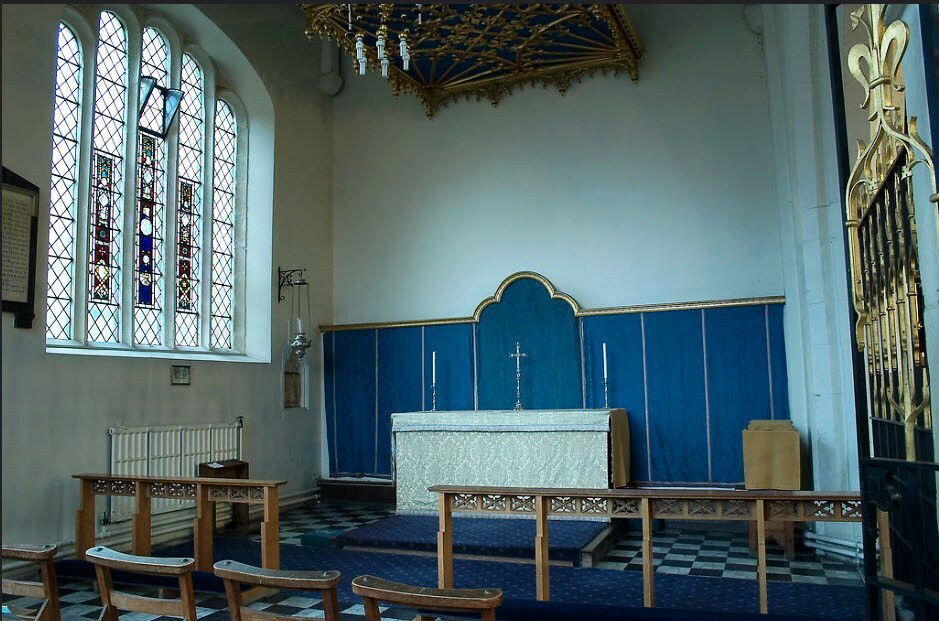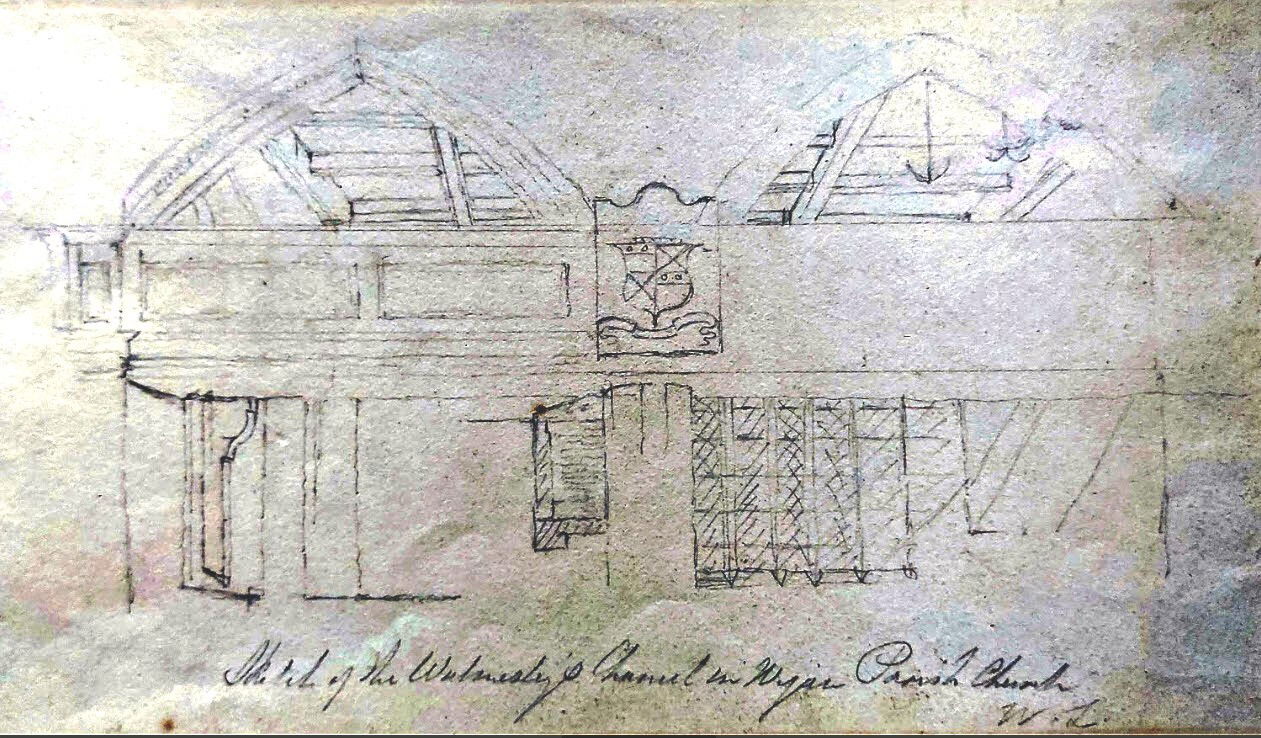Wigan Parish Church - The Walmesley Chapel

THE WALMESLEY CHAPEL
The Chapel is that which opens off the North Aisle commonly known as the Walmesley Chapel but known at different times as the Gerard Chapel and the Gerard-Walmesley Chapel.
The date of its foundation and its original dedication are unknown but it seems to have been founded towards the end of the Middle Ages as un unendowed chantry by the Gerards, Lords of the Manor of Ince from about 1400. In 1541-1542 Hugh Cookson, later priest of the Bradshaigh chantry, was serving as a chantry priest at Wigan and was being paid by Thomas Gerard, so it is probable that he was officiating in the Gerard Chapel.
The first definite reference to the Chapel occurs in 1615 when it is recorded in the Parish Register that “ Myles Garran of Ince. Esquire, was buried at Wigan in his owne Chancel.”
The Chapel is one of the oldest parts of the church as it was not rebuilt with the rest of the church between 1845 and 1850. Whether anything remains of the original building is not clear, though the pillar and the arches which divide it from the body of the church may possibly be late medieval.

It appears that when the chantry services were discontinued it fell into ruin along with the Crawford and Legh Chapels. In 1647 the Churchwardens complained to the Quarter Sessions at Wigan that it was “ in great decay, the windows of the same being broken most part down, to the great annoyance and hurt of the said church and especially to the grief of the congregation at such time as they arc present.
The court ordered it to be repaired by those administering the Gerard estates. During the 18th century, William Gerard. 1718- 1764, the last male member of this branch of the Gerard family, apparently hard pressed for money, made a practice of leasing the Chapel and its seats. In 1745 by agreement with William Gerard, James Laland erected and paid for new seats in the Chapel and in return was given a lease of the Chapel, promising to keep it in repair, though Gerard kept a seat for himself and stipulated that none but Gerards should be buried in the Chapel.
After some difficulties caused by the death of James Laland. this lease was given up in 1751 but later in the same year Gerard again leased some of the scats and in 1756 he leased two seats in a gallery in the Chapel which was described as “ lately erected and built.”
In 1760 he prepared plans for pulling down the pillar and arches between the Chapel and the North Aisle so that the gallery would have a better view into the church and thus be more useful and profitable, but this was apparently never carried out.
A plan of the Chapel drawn up in 1751 shows that the structure of the Chapel was much the same then as now, but it was completely filled with pews facing towards the church and there was a door at the extreme western end of the north wall.

In 1830 Charles Walmesley constructed a vault beneath the Chapel, the entrance of which can be seen in the present floor. It contains four coffins, the last burial taking place in 1850.
Many generations of the Gerards and Walmesleys were buried in the Chapel but until the vault was made they seem to have been buried in ordinary graves. In the restoration of the church between 1845 and 1850 the gallery of 1756 was taken down and the window at the east end of the Chapel in the Tower wall, presumably blocked up when the Chapel was built, was opened up again, but otherwise the Chapel was not altered.
It was thoroughly restored between 1898 and 1901, under the supervision of local architect George Heaton, by Humphrey Walmesley of Westwood House. The exterior was repaired. The old box pews were removed. The floor was levelled and tiled in black and white and a handsome iron screen, made by Hardman and Powell, was installed between the Chapel and the North Aisle.
At the same time, three old hatchments were transferred from the Chapel of Westwood House and put in the Chapel. The Gerards of Ince, who almost certainly founded the Chapel, became staunch adherents of the Roman Catholic Church after the Reformation and suffered many difficulties because of their religion.
About 1667 Thomas Gerard, the last male member of the family, sold his estates and the Chapel to his cousin. Col. Richard Gerard, one of the Gerards of Bryn. The last male member of this branch of the family was William Gerard (d. 1764), whose sister and heiress married John Walmesley.
In this way the Chapel, along with the Manor of Ince. passed into the hands of the Walmesley’s who were also Roman Catholics. Thus there was the unusual position of a Chapel in an English parish church being owned by a Roman Catholic family.
After the Chapel had been restored by Humphrey Walmesley, by an agreement of 1907, the Rector and Churchwardens were allowed to use it for certain purposes but they were forbidden to erect an altar there or to celebrate the Holy Communion. C.C. Thicknesse, Rector, 1922- 1936, anxious to furnish a Chapel for the saying of the daily offices and the daily celebration of the Holy Communion, twice, in 1922 and again in 1935. asked for permission to use the Walmesley Chapel for this purpose but with no success.
Eventually, however, in 1955. having been approached by the present Rector, Colonel C.T.J.G. Walmesley relinquished his rights in the Chapel and handed it over to the Church. It was then completely restored. The old lath and plaster roof being decayed and beyond repair, an entirely new plain modem wooden roof was substituted.
The Chapel was then refurnished under the direction of J. B. S. Comper. The irregularly placed window in the east wall between the Chapel and the Tower which had been blocked up when the Chapel was built and re-opened between 1845 and 1850 was »gain walled up. Heating was installed, the whole Chapel was re-plastered and then whitened.
An altar, under an elaborately decorated tester was set up and furnished. An aumbrey. with a lamp of antique Italian silver, was built in the north wall, and the screen was gilded.
The restored Chapel was dedicated on 3rd October, 1957, by the Bishop of Liverpool as a Chapel of the Resurrection. Here the names of deceased parishioners and benefactors are recorded and they are remembered year by year at a weekly celebration of the Holy Communion, so that the Chapel is now fulfilling the same sort of purpose for which all the Chapels in the church were originally built. Here, too, is reserved the Blessed Sacrament for the Communion of the sick and the Chapel provides a quiet place for meditation and prayer.